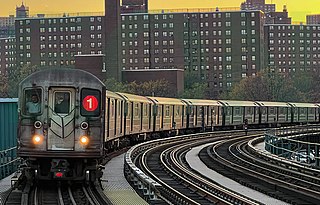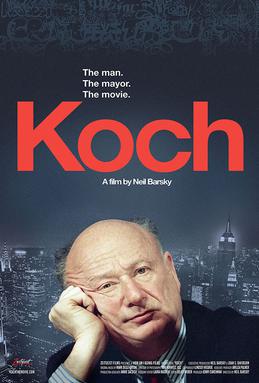
The French Connection is a 1971 American neo-noir action thriller film directed by William Friedkin and starring Gene Hackman, Roy Scheider, and Fernando Rey. The screenplay, by Ernest Tidyman, is based on Robin Moore's 1969 nonfiction book. It tells the story of fictional New York Police Department detectives Jimmy "Popeye" Doyle and Buddy "Cloudy" Russo, whose real-life counterparts were narcotics detectives Eddie Egan and Sonny Grosso, in pursuit of wealthy French heroin smuggler Alain Charnier.

The New York City Subway is a rapid transit system in the New York City boroughs of Manhattan, Brooklyn, Queens, and the Bronx. It is owned by the government of New York City and leased to the New York City Transit Authority, an affiliate agency of the state-run Metropolitan Transportation Authority (MTA). Opened on October 27, 1904, the New York City Subway is one of the world's oldest public transit systems, one of the most-used, and the one with the most stations, with 472 stations in operation.

The J Nassau Street Local and Z Nassau Street Express are two rapid transit services in the B Division of the New York City Subway. Their route emblems, or "bullets", are colored brown since they use the BMT Nassau Street Line in Lower Manhattan.

The Taking of Pelham One Two Three is a 1974 American crime drama film directed by Joseph Sargent, produced by Gabriel Katzka and Edgar J. Scherick, and starring Walter Matthau, Robert Shaw, Martin Balsam and Héctor Elizondo. Peter Stone adapted the screenplay from the 1973 novel of the same name written by Morton Freedgood under the pen name John Godey.

The Brighton Beach station is an elevated express and terminal station on the BMT Brighton Line of the New York City Subway. It is located over Brighton Beach Avenue between Brighton 5th Street and Brighton 7th Street in Brighton Beach, Brooklyn. The station is served by the Q train at all times and is the southern terminal for the B train on weekdays only.
The BMT Canarsie Line is a rapid transit line of the B Division of the New York City Subway system, named after its terminus in the Canarsie neighborhood of Brooklyn. It is served by the L train at all times, which is shown in medium gray on the New York City Subway map and on station signs.
The IND Culver Line is a rapid transit line of the B Division of the New York City Subway, extending from Downtown Brooklyn south to Coney Island, Brooklyn, New York City, United States. The local tracks of the Culver Line are served by the F service, as well as the G between Bergen Street and Church Avenue. The express tracks north of Church Avenue are used by the <F> train during rush hours in the peak direction. The peak-direction express track between Ditmas Avenue and Avenue X has not seen regular service since 1987.

The New York City Subway is a rapid transit system that serves four of the five boroughs of New York City, New York: the Bronx, Brooklyn, Manhattan, and Queens. Its operator is the New York City Transit Authority (NYCTA), which is controlled by the Metropolitan Transportation Authority (MTA) of New York. In 2016, an average of 5.66 million passengers used the system daily, making it the busiest rapid transit system in the United States and the seventh busiest in the world.

Henry Chalfant is an American photographer and videographer most notable for his work on graffiti, breakdance, and hip hop culture.

The Newkirk Plaza station is an express station on the BMT Brighton Line of the New York City Subway in Flatbush, Brooklyn. It is located on an open-cut at the center of the pedestrian-only Newkirk Plaza shopping mall, which is bounded by Newkirk Avenue on the north, Foster Avenue on the south, Marlborough Road to the west, and East 16th Street to the east. The station is served by the Q train at all times and by the B train on weekdays only.

The Avenue M station, is a local station on the BMT Brighton Line of the New York City Subway. It is located in Midwood, Brooklyn, at Avenue M between East 15th and East 16th Streets. The station is served by the Q train at all times.

The Neck Road station is a local station on the BMT Brighton Line of the New York City Subway. It is located at Gravesend Neck Road between East 15th and East 16th Streets in Homecrest, Brooklyn. The station is served by the Q train at all times.
References to the New York City Subway in popular culture are prevalent, as it is a common element in many New Yorkers' lives.

Woodhaven Junction was a station complex on the Atlantic Branch and Rockaway Beach Branch of the Long Island Rail Road, located at Atlantic Avenue between 98th and 100th Streets in Woodhaven, Queens, New York City. The elevated Rockaway Beach station was closed in 1962 along with the rest of the branch, while the underground Atlantic Branch station was closed and abandoned on January 7, 1977.

Marshall Curry is an Oscar-winning American documentary director, producer, cinematographer and editor. His films include Street Fight, Racing Dreams, If a Tree Falls: A Story of the Earth Liberation Front, Point and Shoot, and A Night at the Garden. His first fiction film was the Academy Award-winning short film The Neighbors' Window (2019).

Graffiti in New York City has had a substantial local, national, and international influence.

Koch is a 2012 documentary film directed by Neil Barsky about former New York City Mayor Ed Koch. Koch premiered at the Hamptons International Film Festival on October 8, 2012 and is distributed by Zeitgeist Films. It opened theatrically in the United States on February 1, 2013 the day Koch's death was publicized.
Manfred Alexander Kirchheimer was an American documentary film maker and professor of film at the School of Visual Arts in New York City. He previously taught at NYIT. He was born in Saarbrücken, Germany, and his family moved to New York City in 1936 to escape Nazi Germany. After receiving a B.A. from the City College of New York in 1952, he worked primarily as a film editor and he also began making his own films. A major theme in many of his documentaries is urban life. His most notable documentaries include: Stations of the Elevated, We Were So Beloved, Tall: The American Skyscraper and Louis Sullivan, and Art Is... The Permanent Revolution.

Champs is a 2014 documentary film focusing on boxers Mike Tyson, Evander Holyfield, and Bernard Hopkins. The film had its world premiere at the Tribeca Film Festival on April 19, 2014. Starz released the film on March 13, 2015, in a theatrical release and through video on demand.

Nasty Baby is a 2015 Chilean-American drama film written and directed by Sebastián Silva and starring Kristen Wiig, Silva, and Tunde Adebimpe alongside Reg E. Cathey, Mark Margolis, Agustín Silva, Alia Shawkat, Lillias White, and Anthony Chisholm.
















